Crashing is part of cycling as crying is part of love.
Johan Museeuw
- The Lion of Flanders
Crashing is part of cycling as crying is part of love.
Johan Museeuw
- The Lion of Flanders

Conquer the Mountain. Find Your Freedom.

Conquer the Mountain. Find Your Freedom.
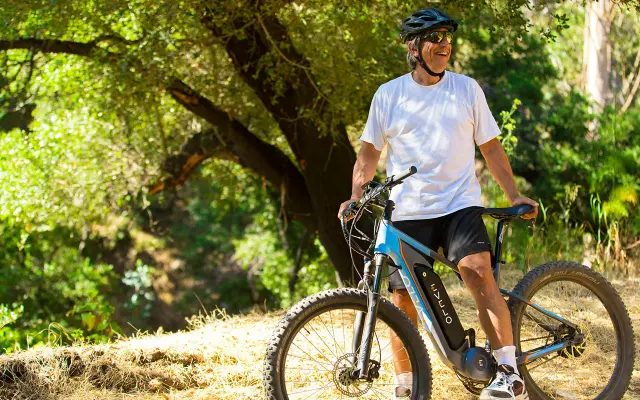
I was cruising along the trail on my trusty hardtail Polygon when I spotted my friend Mike shredding uphill on his brand new e-MTB. Feeling a twinge of envy (and maybe a bit of leg fatigue!), I waved him over.
As we tackled a climb, Mike effortlessly passed a couple of riders. One rider called out, “Hey! E-bikes aren’t allowed here!” Mike politely explained it was a Class 1 electric mountain bike, but the rider seemed unconvinced. This got me thinking…
E-bikes, with their quiet power and assisted pedaling, are expanding access to the outdoors for a wider range of riders. But with this growing popularity comes the need for responsible use and trail etiquette.
This is arguably the most important piece of e-bike etiquette. E-bike regulations can vary depending on where you are. Always check with local land management agencies or trail websites before you head out.
They’ll have the latest information on where you can ride your e-bike, any speed limits, and specific areas that may be off-limits to e-bikes. This helps keep trails safe and enjoyable for everyone.
Understand Your E-Bike’s Capabilities:
E-bikes come in different classes with varying regulations and capabilities. Here’s a quick breakdown:
Class 1: Pedal Assist Only
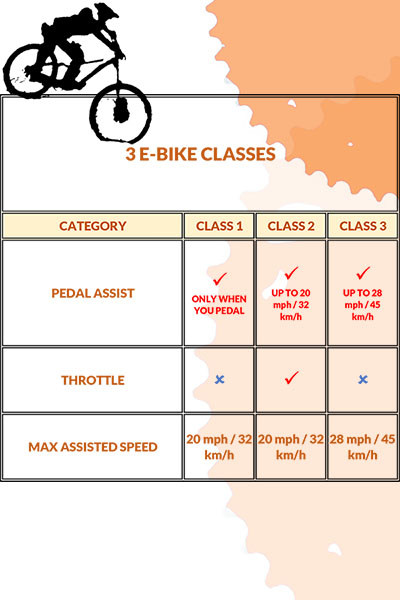
Class 2: Pedal Assist with Throttle
Class 3: High-Speed Pedal Assist
Class 4: Powerful E-Bikes (Not Common)
Exceed 750 watts and have no speed limiters (rare in most areas).
Often treated more like mopeds with registration and licensing requirements.
Before diving into the world of e-bikes, consider these factors to find your ideal match:
Your Riding Terrain:
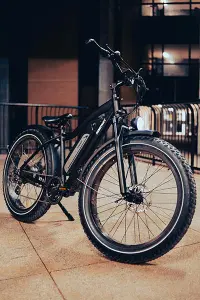
Flat Paths and Commutes: If you’ll primarily be riding on flat paths or commuting, a Class 1 e-bike with a lower motor wattage (around 250W) will likely offer sufficient assistance.
Hilly Terrain and Trails: For tackling hills and light off-road trails, consider a Class 1 e-bike with a higher wattage motor (up to 750W) for more climbing power.
Your Riding Style:
Leisurely Cruising: For a relaxed riding experience, a lower-powered Class 1 e-bike might be perfect.
Exercise with a Boost: If you want a workout with some electric assist, a Class 1 e-bike with adjustable power levels can provide that balance.
Remember: Class 1 e-bikes are generally allowed in most places where traditional bikes are permitted. However, it’s always a good practice to double-check local regulations before you ride.
E-bikes open up new riding opportunities, but it’s important to choose the right trail for a safe and enjoyable experience for everyone. Here’s what to keep in mind:
Match Your Ride to the Trail: E-bikes are ideal for designated multi-use trails shared by hikers, mountain bikers, and equestrians. These trails are typically wider and can accommodate different user speeds.
Respect Single-Track: Narrow, single-track trails designed for bicycles are generally not suitable for e-bikes unless they are specifically designated for e-bike use. Their narrowness can make it difficult to pass safely and can lead to trail erosion.
Know the Rules: E-bikes are often considered motorized vehicles and may not be allowed on non-motorized trails like those for hiking, mountain biking, or horseback riding. Always check signage or with local land managers before hitting the trail.
Ride Designated Routes: If you’re unsure, look for designated e-bike routes or motorized vehicle trails. These areas are specifically designed for e-bikes and other similar vehicles.
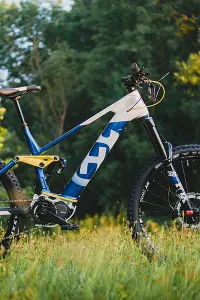
E-bikes are a fantastic way to explore the outdoors, but remember, you’re sharing the trail with others. Here’s how to be a courteous and responsible e-biker:
Be Heard, Be Seen: Announce your presence with a friendly bell ring and maintain a safe distance when passing slower riders or hikers.
Yield with Courtesy: While uphill riders typically have the right of way, consider yielding to everyone uphill, including hikers and horses. E-bikes can restart easier, and this extra courtesy helps build trust and secure future access for e-bikes.
Respect the Trail: E-bikes can contribute to trail erosion just like traditional bikes. Minimize your impact by:
Minimize Noise: Enjoy the natural sounds! Avoid using excessive motor power or loud music that disrupts the tranquility of the outdoors.
Control Your Speed: E-bikes can be faster uphill. Be mindful of other riders. When approaching someone from behind (uphill or downhill), announce yourself friendly and wait for them to yield a safe passing spot.
Be Battery Aware: E-bikes rely on batteries. Plan your ride considering battery life and avoid getting stranded.
E-bikes offer a fun and accessible way to explore the outdoors. Here’s how you can be a champion for responsible e-bike use:
Lead by Example: Always practice good trail etiquette and e-bike safety. Your courteous riding reflects positively on all e-bikers.
Spread the Knowledge: Stay informed about local e-bike regulations and trail rules. Share this information with other e-bike riders to promote safe and enjoyable experiences for everyone.
Support Our Trails: E-bikes can contribute to trail wear. Give back to the trails you enjoy by:
The International Mountain Biking Association (IMBA) is dedicated to creating and protecting great trails for mountain bikers. E-mountain bikes (eMTBs) are a growing trend, and IMBA recognizes their potential to expand access to the outdoors. Here’s a summary of their position:
Shared Use, Separate Category: IMBA recommends managing Class 1 eMTBs as a separate category from traditional mountain bikes, even on shared trails. This helps clarify regulations and user expectations.
Local Decisions: IMBA believes decisions about eMTB access are best made at the local level. Land managers can consider the unique characteristics of eMTBs and trails to determine appropriate shared use.
Public Involvement: IMBA encourages public participation in developing regulations for eMTBs. This ensures all trail users have a voice in the process.
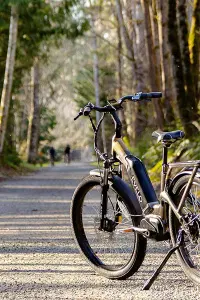
Focus on Class 1: IMBA’s focus is primarily on Class 1 eMTBs, which offer pedal assistance with limited speed and motor power.
Preserving Access: IMBA’s core mission is to protect access to natural trails for traditional mountain biking. They advocate for shared use that doesn’t compromise this access.
Ongoing Collaboration: IMBA is committed to working with all stakeholders, including mountain bikers, eMTB riders, and land managers, to find solutions that benefit everyone.
You might wonder why there isn’t a simple “yes” or “no” answer for eMTBs on non-motorized trails. Here’s the breakdown:
E-bike rules can vary depending on where you ride. Here’s a breakdown of the key differences:
Why Rules Affect Where You Ride: Electric mountain bike riders typically want trail experiences similar to traditional mountain biking. The technical differences in policy are important because they determine where e-bikes can legally go. IMBA, a mountain bike advocacy group, believes working with federal agencies to create thoughtful and legal regulations is crucial for securing future access for e-bikes on public lands.
The International Mountain Biking Association (IMBA) champions both traditional and e-mountain bikes. Here’s their approach to fostering a welcoming environment:
Separate Use Categories: IMBA recommends managing eMTBs as a distinct category within trail classifications. This avoids automatically classifying them alongside traditional bikes, ensuring clearer regulations.
Shared Trails, Managed Use: Many trails can accommodate both types of bikes, but with clear guidelines to minimize user conflicts.
Preserving the Non-Motorized Experience: By managing eMTBs separately, IMBA aims to protect the “non-motorized” designation of traditional mountain biking and ensure continued access to these trails.
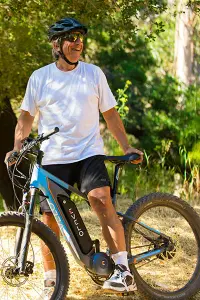
The goal is to allow eMTBs access to suitable trails while ensuring a positive experience for traditional mountain bikers. Here’s how:
E-bikes open new riding opportunities, but require following proper etiquette: understand local regulations, choose the right e-bike for your needs, practice safe riding, and minimize your impact on the trails.
Be courteous to other riders by yielding uphill, controlling your speed, and keeping noise down. Support responsible e-bike use by following IMBA’s recommendations for shared trails and separate categories for electric mountain bikes, ensuring a safe and enjoyable experience for everyone.
Let’s all share the trails responsibly! For a deeper dive into IMBA’s take on eMTBs, check out here.
Keep exploring! Dive deeper with related posts. HERE!
a good overview of e-MTB etiquette for beginners. It covers important topics such as understanding different e-bike classes, being aware of local regulations, choosing the right trail, and practicing courtesy.